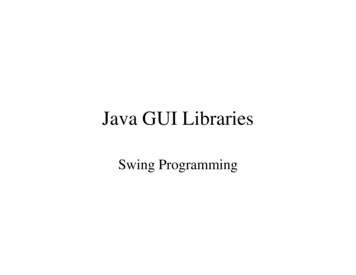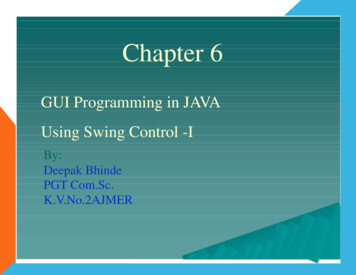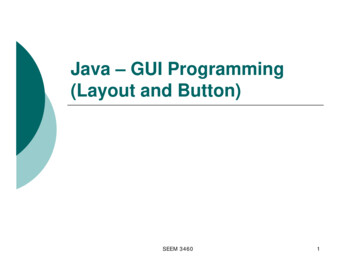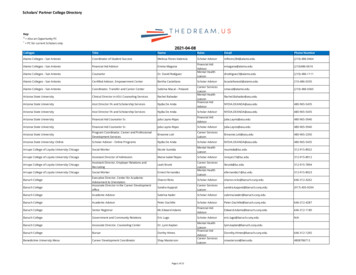
Transcription
Java GUI LibrariesSwing Programming
Swing Components Swing is a collection of libraries that containsprimitive widgets or controls used for designingGraphical User Interfaces (GUIs). Commonly used classes in javax.swing package:– JButton, JTextBox, JTextArea, JPanel, JFrame, JMenu,JSlider, JLabel, JIcon, – There are many, many such classes to do anythingimaginable with GUIs– Here we only study the basic architecture and do simpleexamples
Swing components, cont. Each component is a Java class with a fairly extensiveinheritency JPanelFrameJFrame
Using Swing Components Very simple, just create object fromappropriate class – examples:––––JButton but new JButton();JTextField text new JTextField();JTextArea text new JTextArea();JLabel lab new JLabel(); Many more classes. Don’t need to knowevery one to get started. See ch. 9 Hortsmann
Adding components Once a component is created, it can be added to acontainer by calling the container’s add method:Container cp getContentPane();This is requiredcp.add(new JButton(“cancel”));cp.add(new JButton(“go”));How these are laid out is determined by the layoutmanager.
Laying out components Not so difficult but takes a little practice Do not use absolute positioning – not veryportable, does not resize well, etc.
Laying out components Use layout managers – basically tells form how toalign components when they’re added. Each Container has a layout manager associatedwith it. A JPanel is a Container – to have different layoutmanagers associated with different parts of a form,tile with JPanels and set the desired layoutmanager for each JPanel, then add componentsdirectly to panels.
Layout Managers Java comes with 7 or 8. Most common andeasiest to use are– FlowLayout– BorderLayout– GridLayout Using just these three it is possible to attainfairly precise layout for most simpleapplications.
Setting layout managers Very easy to associate a layout manager with acomponent. Simply call the setLayout method onthe Container:JPanel p1 new JPanel();p1.setLayout(new FlowLayout(FlowLayout.LEFT));JPanel p2 new JPanel();p2.setLayout(new BorderLayout());As Components are added to the container, the layoutmanager determines their size and positioning.
Event handling
What are events? All components can listen for one or more events. Typical examples are:–––––Mouse movementsMouse clicksHitting any keyHitting return keyetc. Telling the GUI what to do when a particularevent occurs is the role of the event handler.
ActionEvent In Java, most components have a specialevent called an ActionEvent. This is loosely speaking the most commonor canonical event for that component. A good example is a click for a button. To have any component listen forActionEvents, you must register thecomponent with an ActionListener. e.g.– button.addActionListener(new MyAL());
Delegation, cont. This is referred to as the Delegation Model. When you register an ActionListener with acomponent, you must pass it the class whichwill handle the event – that is, do the workwhen the event is triggered. For an ActionEvent, this class mustimplement the ActionListener interface. This is simple a way of guaranteeing thatthe actionPerformed method is defined.
actionPerformed The actionPerformed method has the followingsignature:void actionPerformed(ActionEvent) The object of type ActionEvent passed to theevent handler is used to query information aboutthe event. Some common methods are:– getSource() object reference to component generating event– getActionCommand() some text associated with event (text on button, etc).
actionPerformed, cont. These methods are particularly useful whenusing one eventhandler for multiplecomponents.
Simplest GUIimport javax.swing.JFrame;class SimpleGUI extends JFrame{SimpleGUI(){setSize(400,400); //set frames size in pixelssetDefaultCloseOperation(EXIT ON CLOSE);show();}public static void main(String[] args){SimpleGUI gui new SimpleGUI();System.out.println(“main thread coninues”);}}
Another Simple GUIimport javax.swing.*;class SimpleGUI extends JFrame{SimpleGUI(){setSize(400,400); //set frames size in pixelssetDefaultCloseOperation(EXIT ON CLOSE);JButton but1 new JButton(“Click me”);Container cp getContentPane();//must do thiscp.add(but1);show();}public static void main(String[] args){SimpleGUI gui new SimpleGUI();System.out.println(“main thread coninues”);}}
Add Layout Managerimport javax.swing.*; import java.awt.*;class SimpleGUI extends JFrame{SimpleGUI(){setSize(400,400); //set frames size in pixelssetDefaultCloseOperation(EXIT ON CLOSE);JButton but1 new JButton(“Click me”);Container cp getContentPane();//must do thiscp.setLayout(new }public static void main(String[] args){SimpleGUI gui new SimpleGUI();System.out.println(“main thread coninues”);}}
Add call to event handlerimport javax.swing.*; import java.awt.*;class SimpleGUI extends JFrame{SimpleGUI(){setSize(400,400); //set frames size in pixelssetDefaultCloseOperation(EXIT ON CLOSE);JButton but1 new JButton(“Click me”);Container cp getContentPane();//must do thiscp.setLayout(new er(new MyActionListener());cp.add(but1);show();}public static void main(String[] args){SimpleGUI gui new SimpleGUI();System.out.println(“main thread coninues”);}}
Event Handler Codeclass MyActionListener implements ActionListener{public void actionPerformed(ActionEvent ae){JOptionPane.showMessageDialog(“I got clicked”, null);}}
Add second button/eventclass SimpleGUI extends JFrame{SimpleGUI(){/* . */JButton but1 new JButton(“Click me”);JButton but2 new JButton(“exit”);MyActionListener al new how();}}
How to distinguish events –Lessgood wayclass MyActionListener implents ActionListener{public void actionPerformed(ActionEvent ae){if xit(1);}else if (ae.getActionCommand().equals(“Click me”){JOptionPane.showMessageDialog(null, “I’m clicked”);}}
Good wayclass MyActionListener implents ActionListener{public void actionPerformed(ActionEvent ae){if (ae.getSource() but2){System.exit(1);}else if (ae.getSource() but1){JOptionPane.showMessageDialog(null, “I’m clicked”);}}Question: How are but1, but2 brought into scope to do this?Question: Why is this better?
Putting it all together See LoginForm.java example in class notes
Swing Components Swing is a collection of libraries that contains primitive widgets or controls used for designing Graphical User Interfaces ( GUIs). Commonly used classes in javax.swing package: – JButton, JTextBox, JTextArea, JPanel, JFrame, JMenu, JSlider, JLabel, JI










